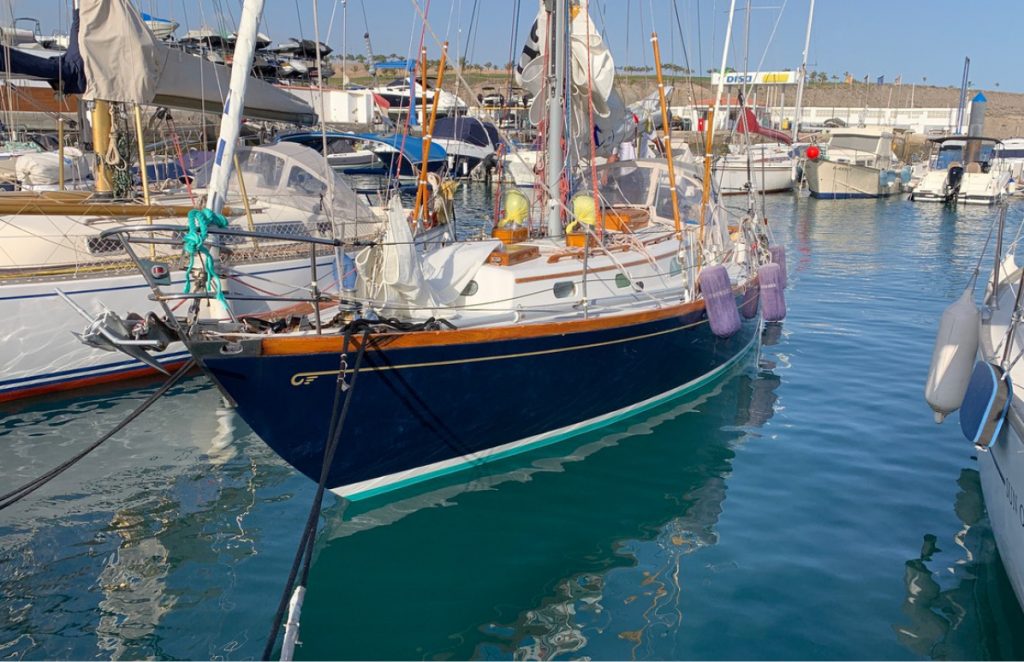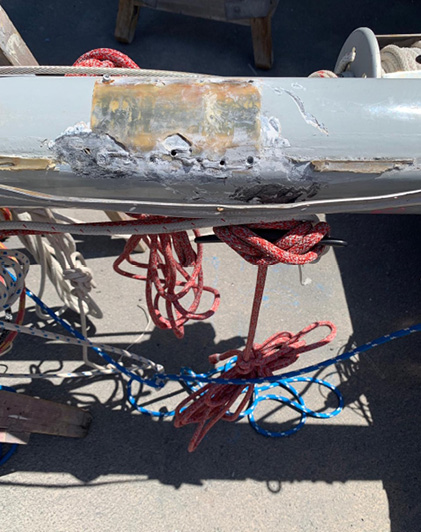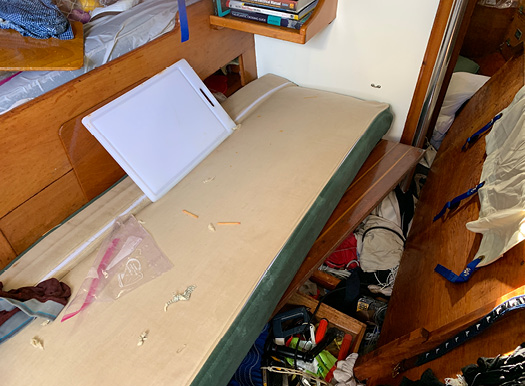Story and photos by Louis Meyer, Cruising Club of America Essex Station
I had a simple two-part plan.
Part 1: I’d sail Strummer, my Pilot 35, transatlantic from Connecticut
to the Azores. Part 2: I’d sail her home.

Strummer floating on her lines for the moment immediately after arrival at Pasito Blanco
In June 2018, I left Stonington, and 23 days later I arrived at Horta. A bit later, we sailed to Madeira, where I had Strummer hauled and stored on the hard in anticipation of a 2019 launch for the homeward leg. She seemed to be well taken care of, with all arrangements made and good people responsible for her.
Part 2 started to unravel. That summer, I got an official-looking email — in Portuguese. With Google Translate help, I learned I was being informed that the boatyard had lost its lease, I was now responsible for Strummer, and would I please remove her from the property? After many anxious emails and a few phone calls, I was reassured that the situation wasn’t quite that dire: She’d “probably” be safe if I left her in the yard, and there would “probably” be a new yard management team in place for my scheduled January launch. The plan was OK.
I spent the New Year’s holiday in Madeira with my wife, Iris, and two non-sailing friends. I had promised I wouldn’t even look at the boat; we’d just enjoy a nice vacation. We had a great time. On January 3, Iris and our friends flew home, and I went to the yard to schedule the launch.

A jibe in rough seas ripped the gooseneck mounting plate out of Strummer’s mast.
“We’re sorry,” I was told. “A cable on the travel lift snapped yesterday. We’ve ordered a new one.”
“When do you think it’ll be fixed?” “Maybe a month … maybe.”
I caught a flight home and waited to hear.
In April, the lift was fixed and I was back in Madeira with my friend Scott Kraft, getting Strummer ready for the sail to Gran Canaria, then on to the Caribbean and home. Madeira’s a lot of fun in April; it’s Carnival time. There’s also a lot of wind. It was blowing 20-plus for the entire week it took us to get Strummer set up.
It was a 48-hour downwind romp sailing Strummer the 350 miles from Funchal to Las Palmas. Pretty quick for a 25-foot waterline boat.
Las Palmas is a big, busy port. Lots of ships and even oil platforms get towed in there for maintenance. It’s also got a modern 1,200-slip marina, but unfortunately for us, it was full. The tiny anchorage was also chock-full of boats waiting for slips. But the customs and immigration officers were helpful and let us keep Strummer at their dock for 48 hours, so we got to enjoy some more Carnival in Gran Canaria. Two days later, Scott headed home, and I headed south, planning to catch the trade winds and turn west towards the Caribbean islands.
The wind had not let up; it was still blowing 20-plus from the north, and the seas were 10–12 feet. But Strummer handled it well, and progress was quick. After two and a half days, I was about 400 miles south of the island as night fell. This is when Part 2 fell apart. I had been sailing downwind on starboard tack with a double-reefed main and the working jib, making over 6.5 knots for two and a half days, and I’d been pushed a little to the east. I guess I was a bit tired, and I was about to make a bad call. I waited for a bit of a lull, and I managed a controlled jibe, but before I could set up the preventer on the new tack, a wave knocked the boat around, and the boom violently slammed back and forth. I managed to get things sorted out, and all seemed OK at first, but a closer inspection revealed that the stainless plate holding the gooseneck to the mast had completely sheared off the carbon spar. Not good.
I saw three options: continue to the Caribbean, sail to the Cape Verde islands, or beat back to Gran Canaria. I was too tired to decide. I heaved to and went to sleep.
Nothing had changed by morning: still blowing hard from the north, still big seas, still damaged rig. I contacted my son Todd on the Garmin inReach satellite communication device, and we discussed the options.
Carrying on under jury-rig seemed unwise — a long, slow trip looking for more problems. Sailing to Cape Verde was tempting — it was downwind for about 700 miles — but I wasn’t sure about the services available, and I wasn’t comfortable leaving the boat there. So, it was option three — beat back to Gran Canaria against 20-knot winds and the big seaway.
I got the main stowed, the boom secured, and the trysail up, and I headed north. It was slow going. Strummer got knocked around a lot. It often sounded and felt like we’d hit something solid, but it was just the water slamming into us. It was tiring, but it was progress. Strummer is a wet boat with a low freeboard, and I didn’t notice the small amounts of water coming aboard until the electric bilge pump failed. Hand-pumping a few times a day handled that. Until it didn’t.
After beating north for four and a half days, we were within forty miles of Gran Canaria’s south coast. It was late at night. It was dark. It was rough. I was tired. And now water was coming in faster than I could pump it out. A quick check of the usual suspects — the head, the through hulls, the exhaust, the stuffing box — didn’t reveal the problem. Pretty quickly, the water in the cabin was above my knees, and with the violent boat motion, it was chaos. The wooden drawers and berths were shaking loose and floating along with cushions, books, food, and everything else.
I grabbed the life raft and the abandon-ship bag and went to the cockpit. Maybe I was just too tired to be scared, but I was counting on being OK. I wasn’t injured. I had a raft and a life preserver. The water was warm. And I was in an area with lots of shipping. I felt bad about losing this boat, but we’d had a good run together.

Wrecked interior
I put out the Mayday call, fired some flares, and set off the EPIRB. Within half an hour, I saw a white light. I fired more flares. Yes, it was a ship heading my way. We made radio contact, and he stood off a quarter-mile away. Then a helicopter from Salvamento Maritimo came. I couldn’t contact the copter, but the ship could. I was instructed to launch the life raft and get away from Strummer. It was more difficult than you’d think — the rubber raft was like a trampoline bouncing around in the seas, but the copter downdraft helped to calm things a bit. A rescue swimmer was lowered near the raft. He told me to get in the water, where he hooked me up to his harness and we were hoisted up. I was saved, but Strummer was abandoned and sinking.
The coast guard guys were great. They kept an eye on me at the airport for an hour or so. I got some coffee and toast, took a warm shower, and put on a dry sweatsuit. I called home to tell my family I was OK and hoped they hadn’t been disturbed by the call from SARSAT. I took a taxi into town and found a hotel.
Then the coast guard called to tell me that Strummer was at a slip at Pasito Blanco, an upscale resort/marina on the south coast. A salvage boat had managed to get pumps aboard. I headed over there, and she looked kind of fine — she was scraped and scratched, her stanchions were bent from the salvage operation, and her interior was wrecked, but she was floating on her lines. A few hours later, she wasn’t on her lines anymore: she was still sinking.
I found Chris, the one guy at the yard who spoke English, and explained that the boat needed to be hauled. They were busy with their regular customers and not interested in a sinking boat that had just showed up and might be abandoned, but they relented and put Strummer on the hard. She was safe for the time being.
I spent a few days reviewing things with Mike, the insurance adjuster. It turned out the manual bilge pump diaphragm had ruptured. I hadn’t seen it because it was in the bilge underwater.
At that point, I was delighted. This boat I’d owned for almost thirty years was going to be OK. We’d done nine trips to Bermuda, fifteen or twenty to Maine, and now the transatlantic. We’d be sticking together. I’d get her all fixed up and sail her home next year. Mike and Chris liked the boat and wanted to be my crew.
Then the bills started coming in: hauling and storage, rig removal, engine removal, clean-ups. Next came the estimates: new engine and electrical system, rig repair, salvage damage repair, interior carpentry, and lots more. I started to think it would’ve been better had she gone to the bottom.
Gran Canaria is a long way from Stonington, Connecticut. I realized this was too big a project for me and too far away. It hurt, but I put Strummer up for sale. Mike wound up buying her, fixing her up, and sailing her to the Caribbean with plans to cruise New England. Plans, again. Have you heard about COVID-19? That wrecked Mike’s sailing plans about as thoroughly as the bilge pump had wrecked mine. Strummer went to Grenada for hurricane season, and Mike put her up for sale. In January 2022, I bought Strummer back, and in June and July we sailed home to Stonington. Things work out. ■
Louis Meyer started sailing shortly after moving to Connecticut in 1975, after finishing training as a general surgeon. The purchase of Strummer, a 1967 Hinckley Pilot 35, in 1994 allowed for the expansion of
sailing horizons, and ultimately the realization of his dream to sail across an ocean.
With thanks to the Cruising Club of America in whose magazine, Voyages Issue 65, this article first appeared, and Voyages editors Amelia & Robert Green.
The Cruising Club of America (CCA) is a collection of 1,400 ocean sailors with extensive offshore seamanship, command experience, and a shared passion for making adventurous use of the seas. Their experiences and expertise make them, collectively, one of the most reliable sources of information on offshore sailing. Visit cruisingclub.org to learn more.



